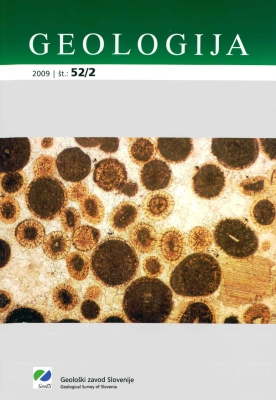The use of SEM/EDS method in mineralogical analysis of ordinary chondritic meteorite
DOI:
https://doi.org/10.5474/geologija.2009.018Abstract
The aim of this study was to evaluate the potential of scanning electron microscopy coupled with energy dispersive X-ray spectroscopy (SEM/EDS) for determination of mineral phases according to their stoichiometry and assessment of mineral composition of ordinary chondritic meteorite. For the purposes of this study, H3 type ordinary chondritic meteorite Abbott was selected. SEM/EDS allows identification and characterisation of mineral phases, whose size is below the resolution of an optical microscope. Mineral phases in chondrules and interstitial matrix were located in backscattered electron (BSE) mode and were assessed from atomic proportions of constituent elements, obtained by the EDS analysis. SEM/EDS analyses of mineral phases showed that Abbott meteorite is characterised by Fe-rich (Fe, Ni)-alloy kamacite, Fe-sulphide troilite or pyrrhotite, chromite, Mg-rich olivine, orthopyroxene bronzite or hypersthene, clinopyroxene Al-diopside, acid plagioclase oligoclase, accessory mineral chlorapatite and secondary minerals Fe-hydroxides (goethite or lepidocrocite). Results of semi-quantitative analyses confirmed that most of analysed mineral phases conform well to stoichiometric minerals with minor deviations of oxygen from stoichiometric proportions. Comparison between mineral phases in chondrules and interstitial matrix was also performed, however it showed no significant differences in elemental composition. Differences in Chemical composition between minerals in interstitial matrix and chondrules are sometimes too small to be discerned by the SEM/EDS, therefore knowledge of SEM/EDS capabilities is important for correct interpretation of chondrite formation.Downloads
How to Cite
Miler, M., Curk, U., & Mirtič, B. (2009). The use of SEM/EDS method in mineralogical analysis of ordinary chondritic meteorite. Geologija, 52(2), 183–191. https://doi.org/10.5474/geologija.2009.018
Issue
Section
Articles

